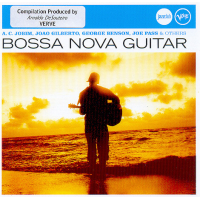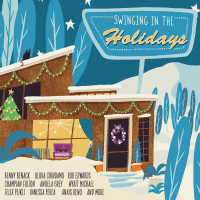Home » Jazz Musicians » Gabor Szabo
Gabor Szabo
An innovative musician who combined the folk music of his native Hungary with his passion for jazz, Gabor Szabo began his study of the guitar at the age of 14. Following a single free lesson that came as a gift with his first instrument, he then began to teach himself to play by emulating the American jazz performers he heard on the radio. Some work with various bands in the Budapest area gradually developed, but in 1956 Szabo was forced to take refuge in Austria by the Communist takeover of Hungary.
Eventually settling in California, Szabo struggled to establish himself as a musician; for a time he worked as a janitor and used his earnings to attend the Berklee School of Music in Boston between 1958 and 1960. Reaching the end of his money, Szabo returned to California and again sought to break into the music field, working in property management to support his family. In 1961, the long-sought opportunity arrived in the form of an invitation to join The Chico Hamilton Quintet. After a somewhat tenuous beginning (Szabo was actually fired by Hamilton and then re-hired later in the year), the guitarist quickly began to establish himself with jazz audiences through his strikingly unique approach to his instrument. It was during this period that Szabo first performed with Lena Horne - an association that would later evolve into a collaborative record and an appearance on Horne's television special in 1970.
By 1965 Szabo had moved on from Hamilton's group, working for a time with The Gary McFarland Quintet and in a quartet fronted by his Hamilton bandmate Charles Lloyd before initiating his solo career in 1966 with the release of “Spellbinder.” A track from this album, “Gypsy Queen,” would later be adapted into the successful single “Black Magic Woman” by the band Santana. In ’66 he also recorded “Jazz Raga,” where he experiments with the sitar, doing some interesting covers. This was an early world fusion excursion.The following year, he formed his own quintet, with whom he recorded a series of albums for the Skye label during the remainder of the decade.
. Concurrent with the growing popularity of rock, Szabo began to integrate the use of feedback into his playing, as well as intergrating aspects of Indian music. Following the dissolution of his quintet, Szabo assembled a sextet; the new band concentrated on a more commercially-accesible style of music and began an active West Coast performing schedule. Numerous collaborative projects also materialized throughout the 1970s - including “High Contrast,” a critically-acclaimed album with Bobby Womack. Another recording “Mizrab,” (1972) revealed the success of his jazz, pop, Gypsy, Indian and Asian fusions.
Read moreTags
Gabor Szabo

by Douglas Payne
Guitarist Gabor Szabo (1936-82) made a big noise in the early 1960s as part of Chico Hamilton's quintet. Szabo, who had one of the most unique sounds in jazz, later went on to play in Charles Lloyd's first quartet and as part of Gary McFarland's group before making a splash on his own. He became especially famed when Carlos Santana covered his “Gypsy Queen" to great acclaim in 1970. These are some of his finest performances. TrackNameTimeArtistAlbum1 ...
Continue ReadingGabor Szabo: Jazz Raga

by C. Andrew Hovan
Although largely ignored today except by astute guitar students, the late Gabor Szabo left behind a large body of work that is still very much misunderstood. A descendent of Hungarian gypsies, Szabo's guitar style was very much in line in with his heritage, full of dark and mysterious textures that were the antithesis of the modern jazz guitar sound of the '50s and '60s. His first recordings with drummer Chico Hamilton announced a new voice that would slowly take shape ...
Continue ReadingGábor Szabó: Jazz Raga

Source:
JazzWax by Marc Myers
Hungarian guitarist Gábor Szabó is, in some respects, a forefather of jazz fusion. In the mid-1960s, his rhythmic guitar style, avant-garde feel and smart interpretations of pop-rock hits paved the way for sophisticated rock experimentation by young jazz guitarists. In most cases, his interpretations of hit songs produced a more interesting listen. Szabó left Budapest when he was 20, in 1956, after the Hungarian Uprising. The revolution was an attempt to rid the country of a Soviet puppet government, an ...
read more
Documentary: Gabor Szabo, 'Rising' (1977)

Source:
JazzWax by Marc Myers
Gabor Szabo was one of jazz fusion's earliest progenitors and a fascinating player. The Hungarian guitarist, who emigrated to the U.S. in 1956, had a singular way of folding together Romani, Indian and rock music in the jazz idiom and seeking out sounds in world music. Szabo also embraced pop with a new level of sophistication. Gabor Szabo died in 1982 at age 45. In 1977, Larry Bock filmed a documentary film on Szabo for his master's project at USC. ...
read more
Gábor Szabó: Gypsy '66

Source:
JazzWax by Marc Myers
Mainstream jazz in the 1960s had a distinct sound. Artists such as Paul Desmond, Jim Hall, Wes Montgomery, Wayne Shorter, Gary Burton, Bill Evans, Miles Davis, Horace Silver and others were influenced by the emerging young-adult scene that ran parallel to the teenage youthquake. Sixties jazz was eclectic and shaded by the revolution in pop music, in some cases stormy and pointed and in others gentle and mystical. One musician whose contribution in the '60s and '70s is overlooked is ...
read more
Lena Horne and Gabor Szabo

Source:
JazzWax by Marc Myers
There are plenty of jazz albums in the rock era that, on paper, never should have worked but did and still do, exceptionally well. Joe Pass's The Stones Jazz (1966) is one. Paul Desmond's Bridge Over Troubled Water (1970) is another. Add Lena & Gabor (1970) to the list. When the album by vocalist Lena Horne backed by guitarist Gábor Szabó was released in 1970, it came out on Skye Records, a label formed in 1968 by Szabó, vibraphonist Cal ...
read more
Jazz Musician of the Day: Gabor Szabo

Source:
All About Jazz is celebrating Gabor Szabo's birthday today!
Gabor Szabo - guitar (1936 -1982) An innovative musician who combined the folk music of his native Hungary with his passion for jazz, Gabor Szabo began his study of the guitar at the age of 14. Following a single free lesson that came as a gift with his first instrument, he then began to teach himself to play by emulating the American jazz performers he heard on the radio...Gabor Szabo - ...
read more
Gabor Szabo: All About Jazz Playlist

Source:
Sound Insights by Doug Payne
All About Jazz's My iTunes Playlists are designed to help music lovers compile their own “best of" iPod playlists or CDR compilations. Here is the playlist I constructed to help introduce new listeners to what I consider to be the best of Gabor Szabo's readily available recordings. Guitarist Gabor Szabo (1936-82) made a big noise in the early 1960s as part of Chico Hamilton's quintet. Szabo, who had one of the most unique sounds in jazz, later went on to ...
read more



































